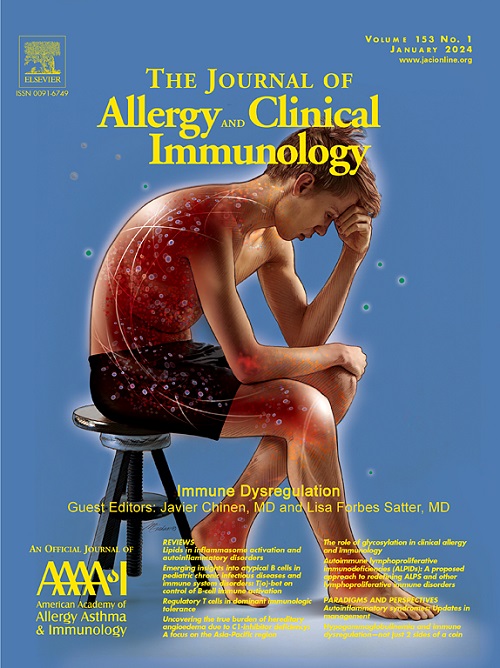A genome-wide meta-analysis reveals shared and population-specific variants for allergic sensitization
IF 11.4
1区 医学
Q1 ALLERGY
引用次数: 0
Abstract
Background
Allergic diseases are major causes of morbidity in both developed and developing countries and represent a global burden on health care systems. Allergic sensitization is defined as the production of IgE specific to common environmental allergens and is an important indicator in the assessment of allergic diseases.
Objective
We sought to clarify the genetic basis of allergic sensitization.
Methods
We performed a genome-wide association study (GWAS) of allergic sensitization in the Japanese population followed by a cross-ancestry meta-analysis with a European population including 20,492 cases and 23,342 controls for Japanese and 8,246 cases and 16,786 controls for Europeans. We also performed a polysensitization GWAS of a Japanese population including 4,923 cases and 17,009 controls.
Results
Allergic sensitization GWAS identified 18 susceptibility loci for Japanese only and 23 loci for the cross-ancestry population, among which 4 loci were novel. Polysensitization GWAS identified 8 significant loci. Expression quantitative trait locus colocalization analysis revealed polysensitization GWAS significant variants affecting both the phenotype and the expression of the CD28, LPP, and LRCC32 genes. Cross-population genetic correlation analysis of allergic sensitization suggested that heterogeneity exists in allergic sensitization between Europeans and Japanese, indicating that more genetic heterogeneity may exist in allergic sensitization than allergic diseases.
Conclusions
Our investigation provides new insights into the molecular mechanism of allergic sensitization that could enhance current understanding of allergy and allergic diseases.
一项全基因组荟萃分析揭示了过敏致敏的共享和人群特异性变异。
背景:过敏性疾病是发达国家和发展中国家发病率的主要原因,是全球卫生保健系统的负担。过敏性致敏被定义为对常见环境过敏原产生特异性免疫球蛋白E (IgE),是评价过敏性疾病的重要指标。目的:本研究旨在阐明过敏性致敏的遗传基础。方法:我们在日本人群中进行了过敏致敏的全基因组关联研究(GWAS),随后对欧洲人群进行了跨祖先荟萃分析,共涉及20,492例日本人和23,342例对照,以及8,246例欧洲人和16,786例对照。我们还对日本人群进行了多致敏GWAS,涉及4,923例病例和17,009例对照。结果:GWAS共鉴定出18个日本人易感位点和23个跨祖先人群过敏致敏位点,其中4个为新位点。我们还发现了8个GWAS多致敏的显著位点。表达数量性状位点共定位分析显示,多致敏GWAS显著变异影响CD28、LPP和LRCC32基因的表型和表达。过敏致敏的跨群体遗传相关分析表明,欧洲人和日本人之间的过敏致敏存在异质性,表明过敏致敏可能比过敏性疾病存在更多的遗传异质性。结论:我们的研究为变态反应致敏的分子机制提供了新的见解,可以增强当前对变态反应和变态反应性疾病的认识。
本文章由计算机程序翻译,如有差异,请以英文原文为准。
求助全文
约1分钟内获得全文
求助全文
来源期刊
CiteScore
25.90
自引率
7.70%
发文量
1302
审稿时长
38 days
期刊介绍:
The Journal of Allergy and Clinical Immunology is a prestigious publication that features groundbreaking research in the fields of Allergy, Asthma, and Immunology. This influential journal publishes high-impact research papers that explore various topics, including asthma, food allergy, allergic rhinitis, atopic dermatitis, primary immune deficiencies, occupational and environmental allergy, and other allergic and immunologic diseases. The articles not only report on clinical trials and mechanistic studies but also provide insights into novel therapies, underlying mechanisms, and important discoveries that contribute to our understanding of these diseases. By sharing this valuable information, the journal aims to enhance the diagnosis and management of patients in the future.

 求助内容:
求助内容: 应助结果提醒方式:
应助结果提醒方式:


